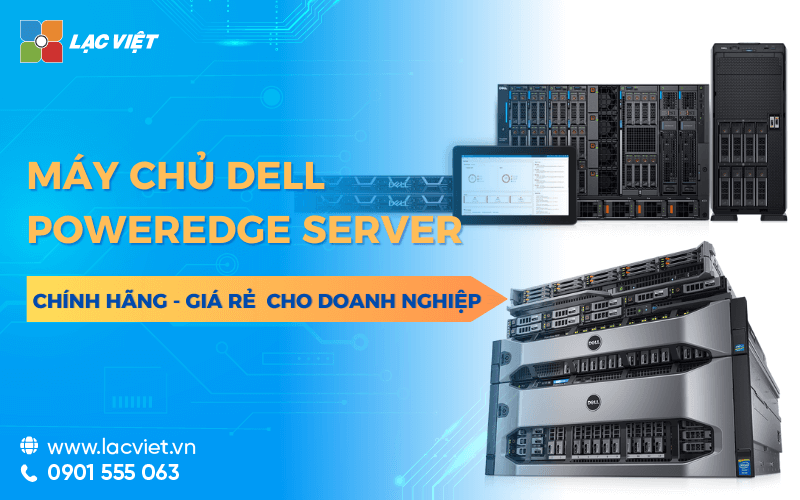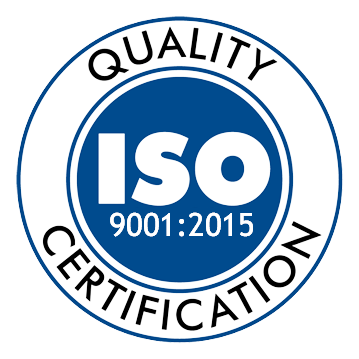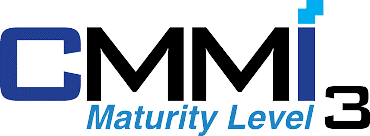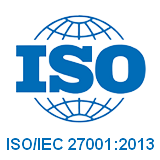Just as a building needs a solid foundation to ensure stability and safety for the entire work, a business should also have a system IT Infrastructure stable to operate effectively and sustainable development. Many businesses still encounter challenges such as system, IT can't expand as the demand grows, the difficulty in integrating new technologies, or are concerned about security issues and operating costs.
In this article, along Lac Viet Computing explore IT Infrastructure is what along with the important components that a system IT should have.
1. IT Infrastructure is what?
IT Infrastructure (IT infrastructure) is a set of components basic technology support services necessary for the deployment and management of systems and information technology in an organization. It includes hardware, software, network, database, cloud services the same resources related to providing, maintaining IT operations in the business.
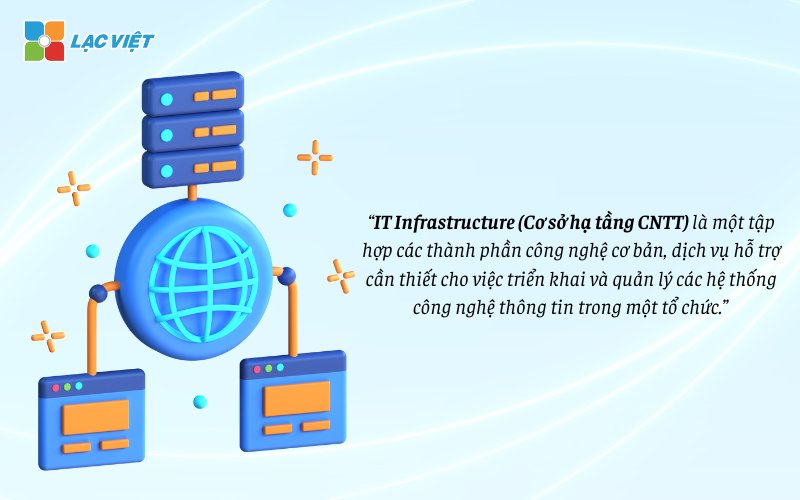
IT infrastructure plays an important role in ensuring operate smoothly of the services of information technology such as data transmission, the communication between the systems, storage, information security. With the continuous development of technology, businesses today can not lack of an IT infrastructure strong to support the development and maintain the competitive edge in the market.
2. 5 main components of IT Infrastructure
IT Infrastructure consists of 5 main components, each element plays an important role in providing the IT services efficiency, stable.

2.1 hardware
Hardware in IT Infrastructure including physical devices such as servers, computers, network devices (routers, switches), storage and other peripheral device. These ingredients are the foundation of physics to the storage, processing, transmission of data.
In which:
- Server provides resources such as storage, networking, application processing.
- Storage devices include hard drives and solid state drives.
- Network equipment including routers, switches, cable system.

2.2 software
The software includes the operating system (Windows, Linux,...), the application management system and the specialized software helps control, manage hardware devices in the network.
In which:
- Operating system is the foundation for the operation of the hardware and application execution.
- Database organization, storage, facilitate access to large volumes of data.
- Software is an intermediate bonding layer to communicate, exchange data between the application software.

2.3 network infrastructure
IT Infrastructure support, IT operations with the data transmission smoothly between the equipment and system. Including all the equipment and technology used to connect the system and the users in the enterprise, from the network device (router, switch) to the technology data transmission, such as LAN, WAN, VPN.

2.4 data center
Data centers are facilities to ensure high availability, redundancy and operational conditions optimal for the IT assets. Cloud services complement the data center by providing online resources, virtual goods to be scalable, flexible, on demand.
Data center support continuity of business, disaster recovery, and dynamic allocation of IT resources to help the company meet effective demand computing, adapt to the changing needs.

2.5 cloud service
The cloud service additional data centers by providing online resources, virtual goods to be scalable and flexible as required. Combine the same data center, cloud support continuity, disaster recovery, dynamic allocation of IT resources, to help the company meet effective demand computing, adapt to the changing needs.
Cloud services provide resources computing virtualization, such as servers, storage, databases via the internet. This helps businesses to expand or shrink the IT infrastructure according to the needs without investing more physical hardware.
3. The type of IT Infrastructure popular today
With the continuous development of technology, the IT infrastructure of your business is becoming increasingly diverse. Organizations can choose between the models, IT Infrastructure different to optimize performance and cost.
Here are three types of IT Infrastructure downloads:
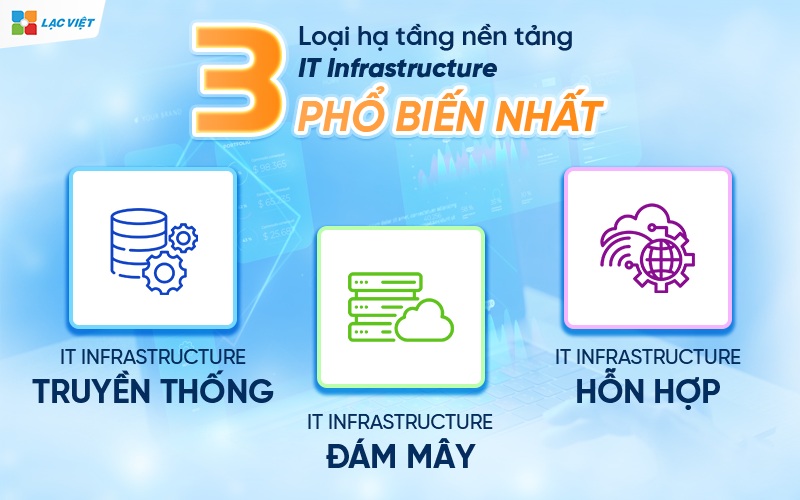
3.1 IT Infrastructure traditional
IT Infrastructure traditional or also known as “On-premise” is the model of IT infrastructure is deployed, the management at the facilities of the business. All hardware, software, network devices are business to invest in and maintain in the data center internal.
Characteristics:
- The cost of the initial investment is high: Businesses have to spend big cost to procure hardware, software, and maintaining the physical infrastructure.
- Complete control: Enterprises have full control over IT infrastructure, from security to maintenance, can be customized according to specific needs.
- Ensure confidentiality: Storage, handling the complete data in the internal environment helps to strengthen information security.
Cons:
- When the demand expansion or changes in technology, businesses must invest more resources, new.
- Businesses have to manage, maintain, upgrade system, this can increase the cost.
3.2 IT Infrastructure cloud
IT Infrastructure cloud using the IT infrastructure services provided over the internet from the cloud provider like Amazon Web Services (AWS), Microsoft Azure, Google Cloud. These services provide resources such as virtual servers, cloud storage and the software management system.
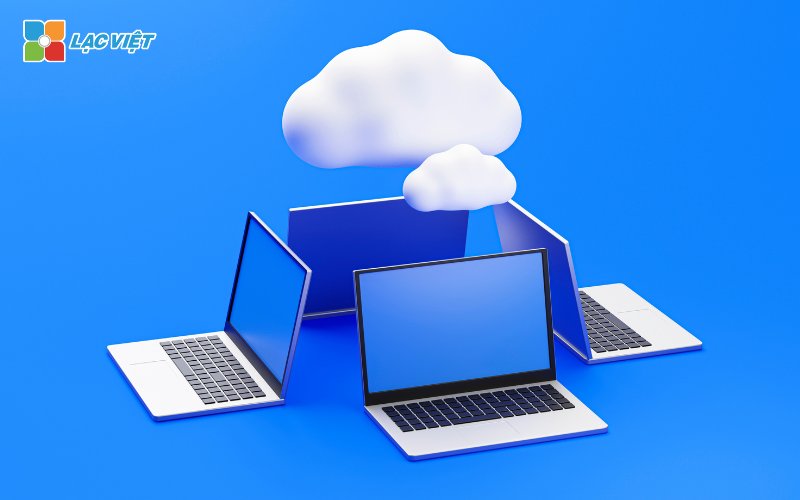
Characteristics:
- Cost flexibility: Cloud services, according to the model of “pay-as-you-go” – only pay for the resources actually used, minimize the cost of the initial investment.
- The ability to expand easily: Businesses can quickly expand or shrink the IT infrastructure according to the needs without having to worry about shopping or maintain hardware.
- High availability: Cloud service provider availability 24/7 and often have contingency measures to help minimize the interruption time.
Cons:
- Although the cloud providers have security measures, but businesses still have to make sure that the data “really” be securely protected on the cloud environment.
- Business will depend on the service provider cloud about the quality of service, time of operation of the system.
3.3 IT Infrastructure mixture
IT Infrastructure mixed combination of the two above models, such system HCI allows businesses to use both systems on-premise and cloud to achieve maximum flexibility in the management of IT resources.
Characteristics:
- Cost optimization: Business can keep these critical system or sensitive on infrastructure and traditional use cloud for applications less important, help optimize costs.
- High flexibility: Business can convert the data, the application between environments on-premise and cloud when needed, to help maximize performance, security.
Cons:
The management at the same time the system on-premise with cloud can become complex, requiring the management tools strong IT team have the experience.
4. Why business should invest in IT Infrastructure
An IT system Infrastructure strong not only helps business to maintain smooth operation, but also plays strategic role in improving business performance and sustainable development. Here are the reasons why businesses need to invest in IT infrastructure:
- Optimize the process of work, from warehouse management, finance to the processing of the order, helping businesses save time, reduce operating costs.
- Minimize the cost of maintenance, repair, replacement hardware devices in the long term.
- Protect critical data and maintain the safety for the information of customers and partners.
- Upgrade system hardware, storage extend or enhance the ability to handle will become easier when there is an IT infrastructure to match.
- Infrastructure the application of advanced technologies such as AI, big data (Big Data), the Internet of Things (IoT),...
- Data backup and system recovery the important data in case of loss or damage.
5. Important factors when designing and construction of IT Infrastructure
When designing and deploying an infrastructure of information technology for business, there are many important factors that need to consider to ensure the system works not only effective, but also have the ability to maintain and develop in the long term.
Here are 4 key elements that every business needs to focus on in the design process, construction, IT Infrastructure.
5.1 scalability
Scalability (scalability) helps to ensure that the IT infrastructure can grow with the expansion of the business. Scalability should be taken into account from the beginning when designing infrastructure to the system can meet the needs of future growth without encountering the problems of performance or stability.
Solutions for business:
- Use the cloud technology: Cloud services to help businesses expand IT infrastructure with ease and flexibility, without the need to invest in new hardware.
- Architectural design module: System infrastructure should be designed in the form of modules, which can be easily added to the hardware or software, new without interruption.
- Use automation software: The automation tools such as server manager virtual automation and configuration will help to minimize the cost and effort when expanding.

5.2 flexibility
Flexibility is the element to create a system that can adapt to the rapid change in technology, the requirements of the business. As technology changes, or when the needs of the business change, IT Infrastructure need to be able to meet these changes with ease.
Solutions for business:
- Application architecture, infrastructure, cloud: Cloud system provides the ability to highly flexible, allows businesses to change the configuration and resources when needed without the need to change physical infrastructure.
- Use the tools, configuration management and system integration: These tools help business easy to update, adjust the system according to the requirements without encountering the problem or reduce performance.
- Select the software and hardware are compatible with high: When selecting the equipment, software should ensure that they can operate in sync with the existing technology, and integrated with the new system in the future.
5.3 Ensure security
According to reports from World Economic Forumhave to 94% businesses around the globe use the cloud, but about 45% of these difficulties related to security and regulatory compliance when deploying to the cloud. Businesses need to ensure that all information, data, and resources in the system are protected in the best way from the external threats as well as risks from insiders.

Solutions for business:
- Use security solutions network: Solutions, such as firewalls (firewall), detection systems, intrusion prevention (IDS/IPS), data encryption will help protect the system from threats.
- Performing privacy policy strict: Ensure that the security process is executed, including management, access, multi-factor authentication, and continuous monitoring activities on the system.
- Training employees on security: Staff is one of the “weaknesses” in the security system. Businesses should train employees about the security threats and how to identify them can help minimize the risks.
5.4 Cost
The design and construction of a system IT Infrastructure must be considered carefully in order not to exceed the budget of the business, at the same time ensuring efficiency in the long term.
Solutions for business:
- Choose the cloud solution: Use of cloud services will help enterprises reduce the cost of the initial investment in hardware, at the same time pay only for the resources actually used.
- Optimize the existing resources: The resource optimization and system configuration helps to reduce operating costs, for example, minimize the use of unnecessary resources or refine existing systems.
- Calculate the overall cost (TCO): To ensure reasonable cost, enterprises need to calculate the overall cost (TCO), including the cost of procurement, maintenance, commissioning, system upgrades.
6. Barriers to deployment of IT infrastructure and solutions for business
Barrier when applied innovations in IT Infrastructure
To deploy effective cloud, businesses often face a number of barriers significantly in the process of overhauling IT infrastructure traditions. Here are 5 barriers downloads:
- Data center traditional: Many businesses have invested in data center, internal leads to long-term commitment and maintenance costs big. However, the center traditional data no longer match up with the growing demand of rapid and sustainable today.
- Property owner hardware: The investment in hardware attached to the cycle depreciation from 3 to 5 years that the budget is “freeze”. This limits the flexibility in the transition to the cloud model new and optimize financial resources.
- Software license: The organization spent about 35-55% IT budget for software, many of which are software't be used effectively. The lack of management and isolation data, which cost software becomes unnecessary burden.
- Skills staff: Team IT usually trained according to the traditional technology. With speed rapid development of digital technology, many businesses have difficulty in updating skills and rotation of personnel to meet the needs of continuous innovation.
- Platform old server: Many organizations still use the host system as old as COBOL, CICS, and DB2 to operate the important transactions. The extension of this application to the cloud requires modernization process complex and expensive.
These barriers is a major obstacle for the transition number and avail the maximum benefits from cloud.
Infrastructure solutions information technology “all in one” for business
To ensure that the business always operate efficiently and compete in the business environment, challenging the upgrade of IT infrastructure is essential. Vietnam with 30+ years of experience in the design, deploy and maintain the solution of IT infrastructure for business, committed to bringing you optimal solutions help business activity, stability, security.
Lac Viet provider of solution IT infrastructure comprehensively covers all of the important components of IT Infrastructure such as hardware, software, network, data center and security. Based on the needs and peculiarities of each business, Lac will advise deploy the optimal system, helps to improve work efficiency, save costs, improve security.
- Hardware and software: Lac Viet provide, deploy the system hardware from the leading suppliers such as Dell, Cisco and the software to manage the system effectively helps optimize data protection of business.
- Network solutions: System network business is Lac Viet designed to ensure speed, reliability, highest security. Network solutions include structure, LAN/WAN, VPN connection, wireless network (Wifi), network security along the solution to recover after a disaster.
- Cloud services: Lac Viet provider of cloud services, flexible from the reputable supplier, helping business to expand resources on demand without having to worry about the maintenance and hardware maintenance.
Not merely supporting components, which infrastructure CNT is the backbone for all activities of the business in the digital era. From the ensure system operation stability, cost optimization to adapt quickly with the development of technology, IT Infrastructure play a decisive role in building competitive advantage, shaping the long-term success. Lac Viet confidence accompany your enterprise on the transition of system optimization and achieve great progress in business.
CONTACT INFORMATION:
- Lac Viet Computing Corporation
- Hotline: 0901 555 063 | (+84.28) 3842 3333
- Email: info@lacviet.vn – Website: https://lacviet.vn
- Headquarters: 23 Nguyen Thi Huynh, P. 8, Q. Phu Nhuan, Ho Chi Minh city






